#st james the apostle
Photo

Urbano Lugris González (Spain, 1908-1973)
Urbano Lugris GonzálezTraslado de los restos del Apostól Santiago
103 notes
·
View notes
Text
The Legends of St. James the Greater [citation needed]
Because I'm doing the Camino de Santiago next spring, I've been reading stuff about St. James the Greater, because the stories around him are why the Camino exists in the first place.
And, oh my god, they're Something Else. Because nearly everything I read is either 1. extremely unlikely 2. kinda wince-inducing. at best.
I want to make it clear: I don't think it matters, at this point, how much of his post-Biblical legends are factually true, in regards to walking the Camino. People have been making sincere pilgrimages to Santiago de Compostela for so long that bits of him might as well be there, yeah? It's became a sacred place devoted to one of the first of Jesus' apostles whether his actual bones are there or not. Also, quite frankly, many of the legends aren't any more or less believable than anything in the Gospels themselves. Disclaimer over.
Things that were recorded soon enough after they supposedly happened that they are the likeliest to be true:
He was one of the first apostles of Jesus, along with his brother John. The two brothers (plus Peter) were witnesses to some of the more notable parts of Jesus' life and ministry. He was also the first apostle to be martyred; beheaded by sword on the order of Herod in 44 AD. (His beheading is in Acts 12:2, just one sentence: "He [Herod] had James, the brother of John, killed with the sword.")
After that...things get...weird.
Legend has it that he traveled all the way to what is modern-day Spain to preach the Gospel there, and that after he came back to Jerusalem and was beheaded, his body was miraculously taken by angels and set in a boat that washed up on the coast of Spain. During a wedding. Which spooked a horse and rider. Who fell into the ocean. And then emerged miraculously unharmed and covered in scallop shells...and that's part of why scallop shells are symbols of St. James and pilgrimage to Santiago de Compostela. Yeah, okay.
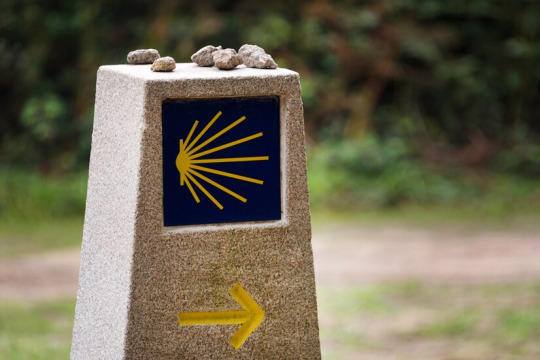
"Oh thank God, I'm not lost." And yes, lots of people get some variation of this as a tattoo. (I know I probably will, ahaha.)
(That all said: there's an Armenian Apostolic Cathedral in Jerusalem that claims to have his head. So maybe the angels only took the rest of him. Who knows? Not me.)
At some point his relics were moved to the location of what is now Santiago de Compostela by some disciples of his (from his earlier visit to Spain? I think?), and the fact that the relics were there was revealed to a hermit by a field of stars in 814. He reported this to a bishop, who told the local king, who built a chapel on that site and is said to be the first pilgrim to Santiago. The chapel became a church in 829, the church was burned down by the Moors in 997, and in 1075 the king started building a cathedral there (it was finished in 1211). In the 900's pilgrims started arriving from all over Europe, and once the cathedral got started their numbers increased dramatically. Both St. Francis of Assisi and Margery Kempe did pilgrimages to Santiago, for instance. Margery did it multiple times, bless her.
But here's the thing: somehow nobody noticed the whole "his body is in Spain" thing until that hermit? And just coincidentally, this was a time when the Catholic church was trying to stamp out the remnants of a particularly popular heresy that had started in Spain. Just saying.
But wait, there's more!
Another thing that was happening in the 800's and for, y'know, a LONG time after (seriously it went on from 711 to 1492); was Christians and Muslim Moors fighting over Spain.
The Christians of Spain named St. James as their patron and protector, in part due his miraculous help in a battle that, uh, never actually happened. The date of the battle is given as 843 or 844, but somehow was never recorded until 300 years later. (Are you sensing a theme here, because I am.)
St. James is therefore sometimes portrayed as Santiago Matamoros, aka St. James the Moor-Slayer. A lot of medieval imagery of him portrays him on horseback, slaughtering people. 😬 Many of the old churches along the Camino include this portrayal--and some of those churches were originally mosques. Oof.
CAN IT GET WORSE? YES.
Look, I'm just going to copy/paste from the wikipedia page on this one: "The iconography of James Matamoros was used in the Spanish colonization of the Americas as a rival force to the indigenous gods, and protector of Spaniards from the indigenous peoples of the Americas. He was depicted as a conquistador."
I mean, thankfully; I won't run into much of that in Spain. But...euggghh.
Anyway.
I kinda feel bad for the actual James, who was just a fisherman working with his dad and brother before becoming one of Jesus' close friends. James was just A Guy! The other apostles apparently found him and his brother kind of annoying! He sometimes had a bad temper! The stories about him in the Gospels just make him sound so human.
There are two common portrayals of our man James all over the Camino: St. James the Moor-Slayer, and St. James as a pilgrim, wearing a floppy hat and robe and holding a walking stick. Much nicer.

Now that's a guy I'd walk across Spain for.
#camino de santiago#PLZ NOTE i am not a historian#this was literally all pulled from wikipedia#though I'd read a lot of in other places as well#st james the greater#st james the apostle#st. james
5 notes
·
View notes
Text
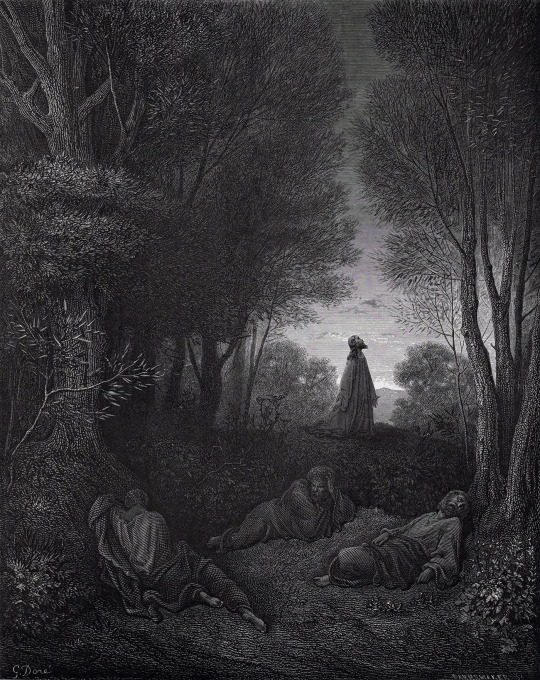
Jesus Praying in the Garden by Gustave Doré
#jesus christ#jesus#christ#art#gustave doré#garden of gethsemane#mount of olives#la grande bible de tours#garden#praying#prayer#agony#peter#john#james#gethsemane#religion#christianity#christian#religious art#bible#biblical#religious#god#james the great#peter the apostle#saint peter#john the apostle#st peter
859 notes
·
View notes
Photo

03/31/2023
The Last Supper, but Judas makes it weird.
Weirder than betraying God, that is.
___
JOKE-OGRAPHY:
Jesus originally just says that one of His apostles will betray him. In this cartoon, He specifies that the one who's invading His personal space is the betrayer. John and James (to Jesus's right and left) both recoil at the thought and start arguing with the others about who could betray Jesus. Meanwhile, Judas coyly says it couldn't be him. Thomas presses "X" to doubt that.
#jesus#john#st john#james#st james the greater#apostles#st peter#st andrew#judas#st thomas#st philip#last supper#bible#bible art#bible humor#catholic#catholic art#catholic humor#catholic memes#christian#christian art#christian humor#christian memes#coquettishly#itd be a lot funnier if his story wasnt so entirely tragic
316 notes
·
View notes
Text
“He who saves a soul saves his own and satisfies for a multitude of sins.”
– St. James the Apostle
33 notes
·
View notes
Text

Saint James the Greater
Died 44 AD
Feast day: July 25
Patron of veterinarians,
equestrians, furriers, tanners, pharmacists
James, son of Zebedee was one of the Twelve Apostles of Jesus. He was the son of Zebedee and Salome and brother of John the Apostle. He is also called James the Greater to distinguish him from James, son of Alphaeus, who is also known as James the Less.
Prints, plaques & holy cards available for purchase here: (website)
60 notes
·
View notes
Text

Szczecin Cathedral, in full the Archcathedral Basilica of St James the Apostle, is a Gothic cathedral located in Szczecin, Poland and seat of the Archdiocese of Szczecin-Kamień. Wikipedia
21 notes
·
View notes
Text
Little James: How do we know when we’ve mess up beyond repair?
Thaddeus: Well...
Nathaniel: When Simon is the voice of reason.
#Incorrect The Chosen quotes#st james the less#Thaddeus the Apostle#rad thad#nathaniel the apostle#The Chosen
56 notes
·
View notes
Text
*Since Tumblr only has 10 options, I left out Judas. Also, there are two Jameses, so pick your favorite in your head.
#st peter#st simon#st jude#st matthew#st thomas#st bartholomew#st philip#st john#st james#st andrew#the twelve apostles#the twelve disciples#jesus#jesus of nazareth#catholicism#catholic saints#christianity#catholic#theology#polls#tumblr polls
25 notes
·
View notes
Text


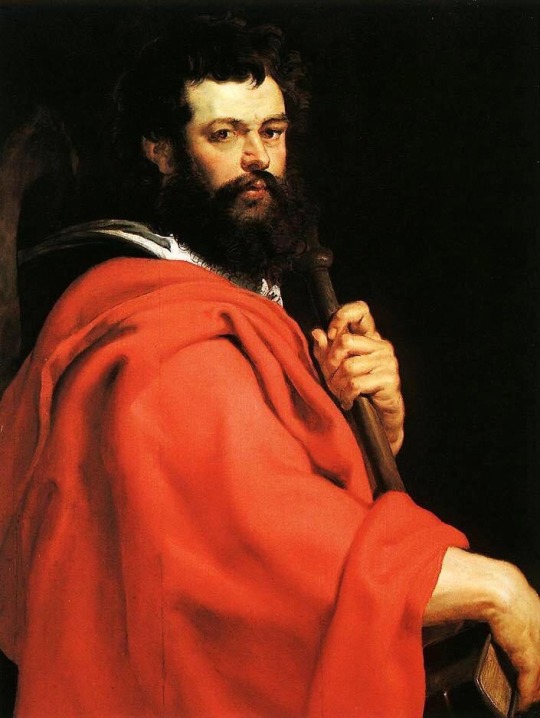
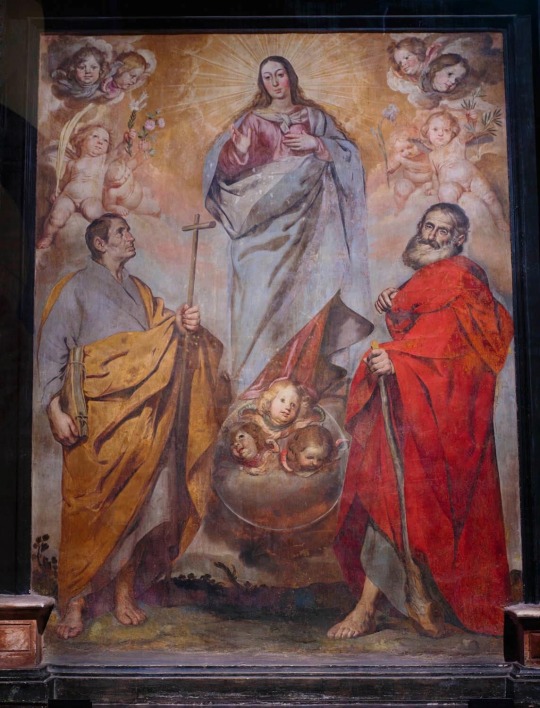



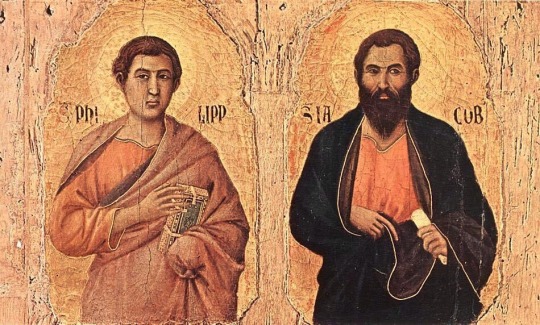
Hodie XI maji... Sanctorum Philippi et Jacobi Apostolorum.
27 notes
·
View notes
Text
May 3 is the feast day of St. Philip and St. James the Little, Apostles
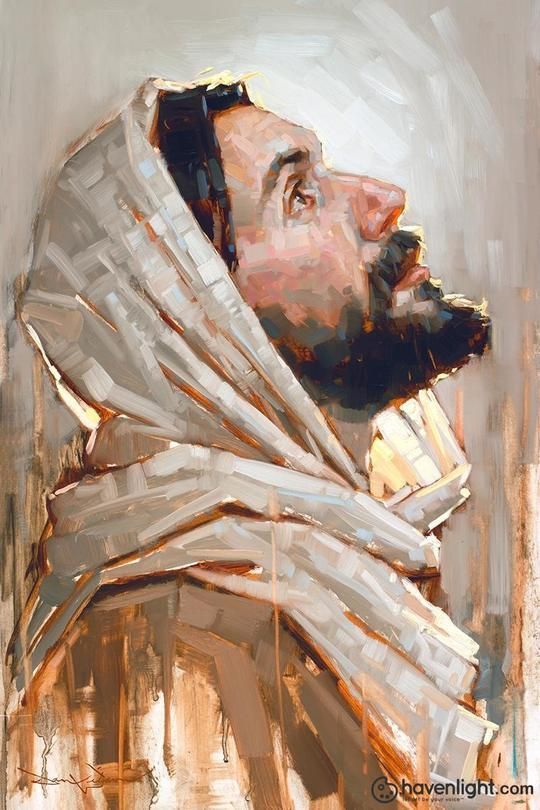
Dan Wilson: Look To God And Live
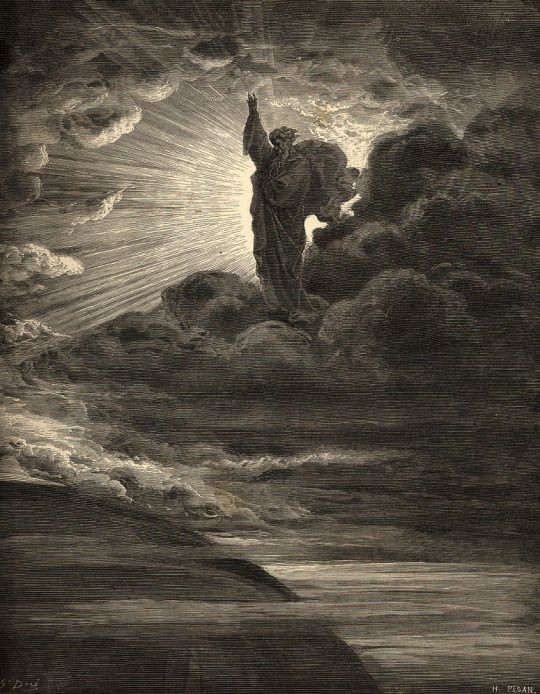
Gustave Doré: God Creating Light
"Anyone who has seen me has seen the Father." John 14:9
#saints#bible quotes#Bible#St. Philip#St. James the Little#Apostle#John 14:9#Anyone who has seen me has seen the Father#God#Jesus#Christ#Jesus Christ#Father#Son#Holy Spirit#Holy Trinity#christian religion#faith#hope#love#stress reliever
17 notes
·
View notes
Text
Daryl’s Pilgrimage: Why Daryl Dixson Season 2's Working Title Was Pilgrim
Most of us know that “Pilgrim” was the working title of DD season 2. I believe they changed it to The Book of Carol to throw yet another bone to Carylers because they will not be getting romantic Carly. No matter what the reason, you can’t escape that Season 2 is about Daryl’s pilgrimage. We have gotten some CRAZY hints that this pilgrimage is all about finding Beth.
Exhibit A: Check out the EXACT matching colors between the signage for DD 2 Pilgrim and Emily’s dress in the video for B or C for effort which came out last Fall during the same time DD 2 "Pilgrim" was being filmed.


Meaning of the word pilgrim:
A pilgrim (from the Latin peregrinus) is a traveler (literally one who has come from afar) who is on a journey to a holy place.
So, what is Daryl’s pilgrimage? It’s his journey to a "holy" place that will make him “hole”. A place that has that “something” he first went out looking for. A place that will contain his happy ending.
The Latin form of “peregriuns” is used for a another famous hunter, the The peregrine falcon (Falco peregrinus), also known simply as the peregrine.

Two interesting facts about these birds are that they mate for life and often travel far, usually to a “high place”, to nest. They have been known to even build their nest in skyscrapers. This bird is similar in coloring to the stuffed penguin Daryl finds on the boat in episode one.
Exhibit B: The Camino de Santiago
This is the pilgrimage mentioned in episode 6 of DD season 1. Here is a little background info on the pilgrimage.
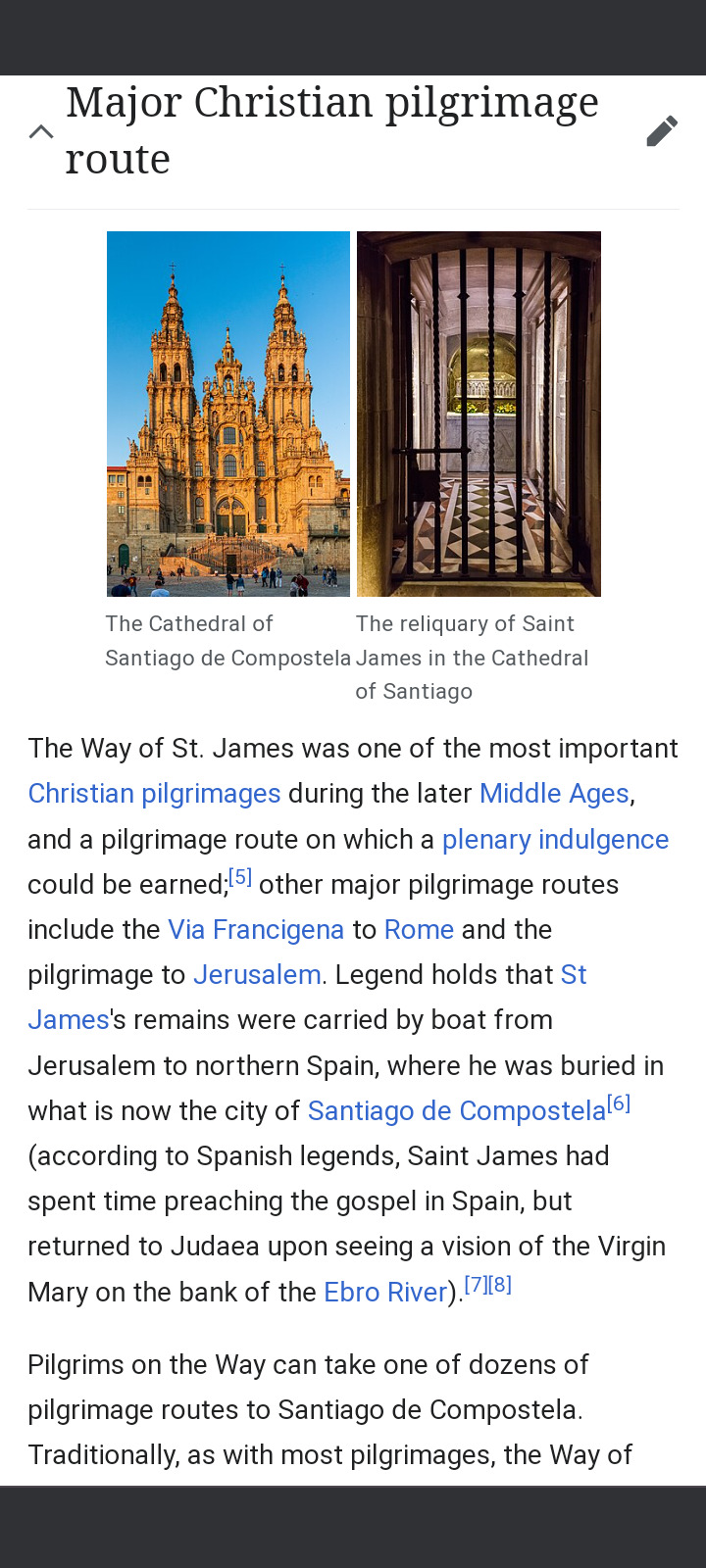
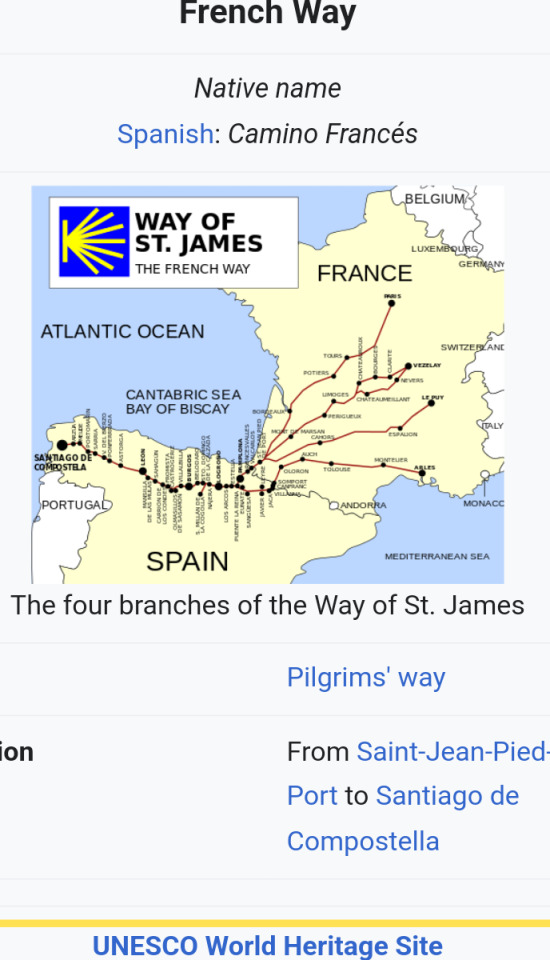
Let’s talk about the Hebrew root of the English name, James:

@angelthefirst1 and @frangipanilove have both done wonderful posts about how Daryl=Jacob/Israel right down to being tied to Leah even though he never loved her. Then, Daryl/Israel had to work another 7 years for his “Rachel” or in Daryl’s case, Beth. Another point here is that Jacob leaves his homeland and journeys a long distance, to his mother's people, and there he finds his love, Rachel. It's on this journey that Jacob has the Jacob's ladder dream and names the spot where his head laid during the dream, Beth-el.
So, you could say that this pilgrimage is the Way of Jacob(Daryl). The route starts in various points in France as seen above but ends at the Santiago de Compostela where St. James' remains are said to be.
Compostela means Field of Stars. It comes from the Latin “campus stellae” and is based on the stars of the Milky Way that, according to legend since the Middle Ages, had been outlined by the apostle St. James and followed by pilgrims to reach his tomb.
So, pilgrims follow these stars from France, across the Pyrenees Mountains to find their way to Santiago de Compostela. This ties in perfectly with the Sirius “Dog Star” symbolism we see throughout TWD.
Daryl Dixon season 2 is all about Daryl’s pilgrimage. This spiritual journey will restore Daryl’s faith in God and lead him to his “happy ending” which will be a family with Beth. Just as it was Jacob's children who are the fathers of all of the nation of Israel, I believe it will be Daryl and Beth's children or their descendants who will "save" what is left of humanity.
#team delusional#beth is coming#bethyl#beth greene lives#team defiance#twd daryl and beth#beth is alive#beth greene
23 notes
·
View notes
Text
Random saints by Sittow or Catherine of Aragon's parents?

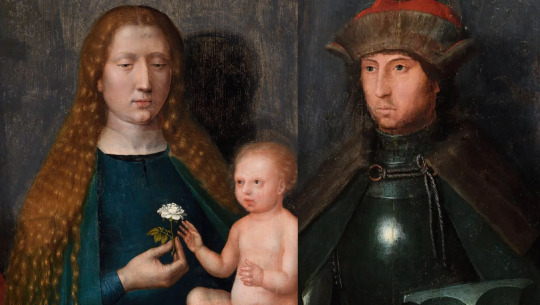
Read further if you wish to know what my theory is.
I first found this photo with mention it is by Sittow and at first I thought it is another portrait of Catherine. But quickly I realised this woman looks older and the features are not exactly the same.
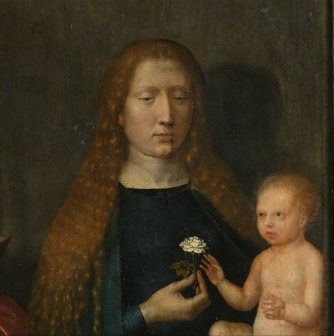
The nose is much narrower. And I started to wonder...we know that Sittow painted at least one portrait of Queen Isabella I of Castile.
And she had such nose. I could exclude possibility some of Catherine's sisters looked like this too, but women in that family tended to be very young-looking for really long.
So the age of sitter already is suggesting that it could be based upon Isabella towards end of her life. And it is also odd for depiction of Virgin Mary to depict woman who is not young...it is point in Isabella's favour.
While many claim Sittow painted Isabella in 1485, he was only born in 1468/1469 and didn't even become indipended master until at least 1488. He is first recorded working in Toledo in 1492. So he'd always be only able to depict Isabella over age of 40. And tbh, if this is her..then she looks great for somebody over 40!
But where is this image? It took me while to track down.
It's detail from wings of theThe Passion Altarpiece (Tallinn), its middle part is from c.1515-1520(with some 17th century additions) by different artist.

But I am not so sure how accurate is the dating of the outer wings by Sittow(1518-1525) which are in very different style, and might have originally belong to different altar middle.

If it is indeed 1518-1525 dating, then imo they are posthumous depictions based upon earlier sketches done from life. Sittow reusing those old sketches, using them as inspiration for his later work.
Link to photos only. Left pannel: https://artsandculture.google.com/asset/the-passion-altarpiece-outer-wing-with-the-virgin-mary-and-apostle-james-the-greater-paintings-of-the-outer-side-of-the-wings-by-michel-sittow-and-his-workshop/BwFnRG1v6gRqmQ
Right pannel: https://arthive.com/artists/75951~Michel_Sittow/works/526786~Saint_Adrian_and_Saint_Anthony
As to where they are located?
-Niguliste Museum(housed in former St. Nicholas' Church), which is part of Art Museum of Estonia(which combines collections from 3 other buildings+ this church). Hence in Tallin, Estonia but be aware there is over 3 km distance in between the church and other buildings.
But if anybody could go there and get us some pictures it'd be great (if it is allowed). Currently Niguliste Museum has exhibition about Sittow:

But back to the pannels. The left one depicts Madonna(Virgin Mary holding baby Jesus) and St. James the Great(apostle and patron saint of Spain:
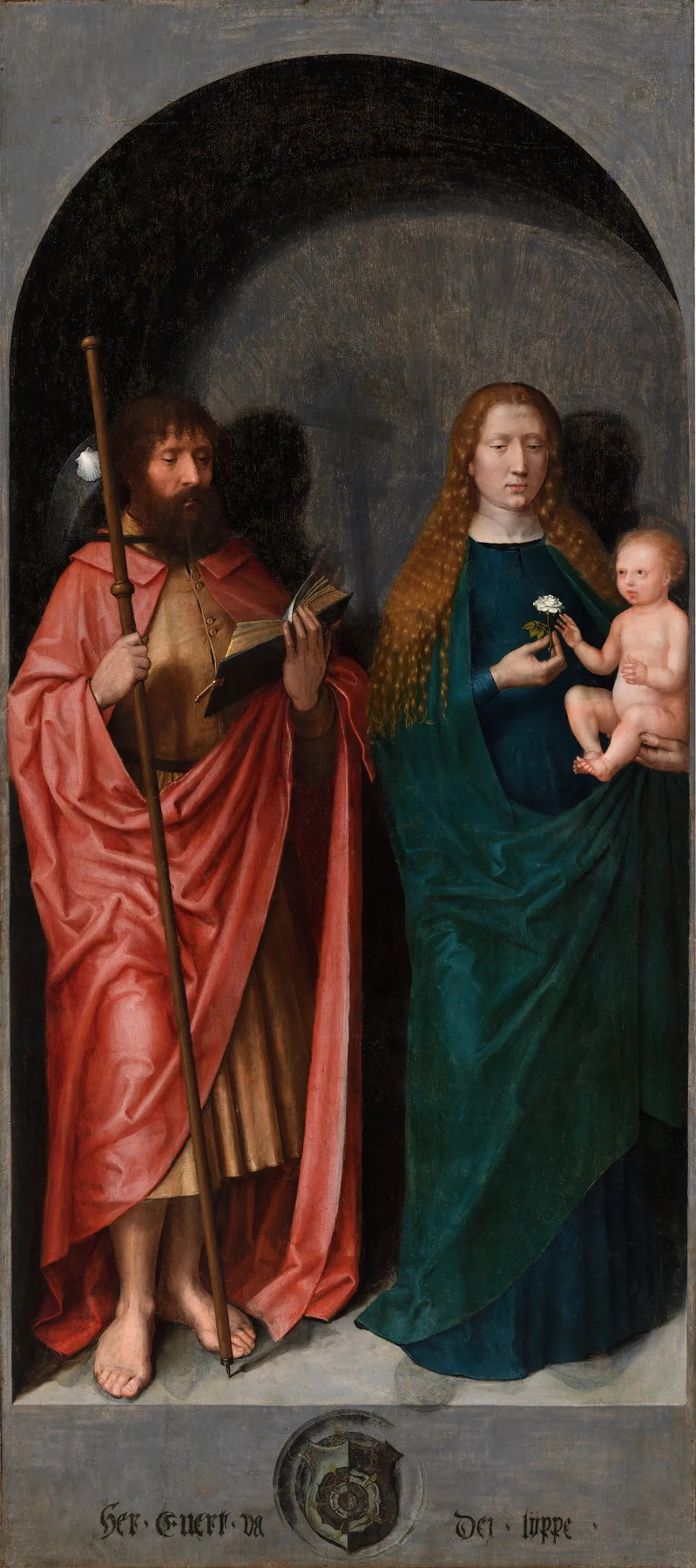
And please note that Tudor rose is combination of red and white rose and not always it was depicted as inner rose white, outer red. Sometimes they were halfed, with inner rose sometiems also switched.

Of course it could be some foreign coat of arms or later alteration.
Right pannel:

Here the coat of arms looks much newer and is probably altered(and if pomegranate turned out to be beneath it, I'd just die...)
The right pannel is depicting two male saints. On right is St Anthony the Great...was father of monasticism(of monastic life)...thus very important saint in christianity...
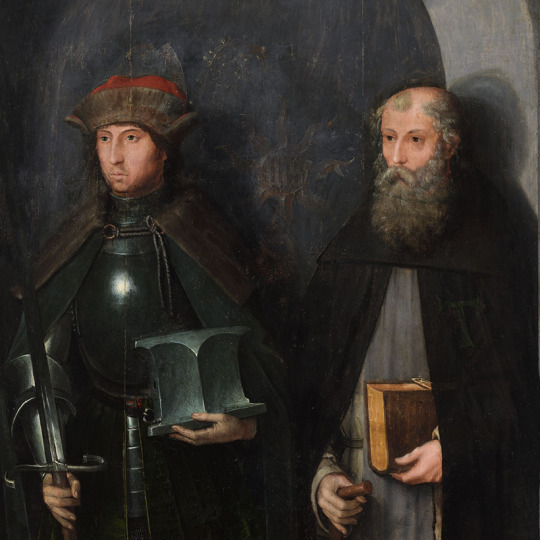
and on left St. Adrian of Nicomedia(2nd most popular military saint after St. George), and imo that's probably King Ferdinand II of Aragon:

It's not great likeness(brows not arched enough, looks bit slimmer, alla of nose not as defined), but overall it's enough of resemblence to not be able to exclude the possibility.
But if this is indeed done years after Sittow was in Spain...and he is reusing his old sketches of catholic monarchs to create this new religious scene(perhaps initially intended for them too, but never made into finished work before), then it is also possible that sketch done in pencil has partially rubbed off...and thus the differences in face of this male.
I think that if this was done while in Spain, such big differences are not very likely to occur. Not that pencil could not rub off, but I think Sittow would have noticed and cared about getting absolutely righ(to please his patrons) and thus would have corrected it.
Ehm, this kitty is supposed to be a lion:
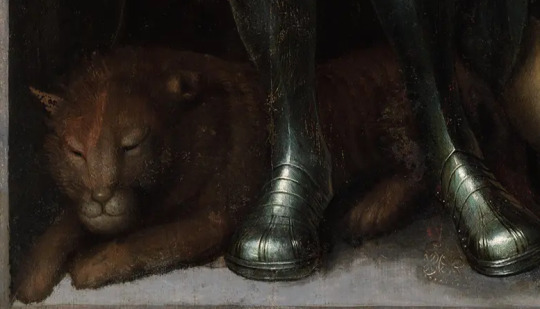
But you must be wondering, if Isabella indeed had this most vivid golden hair colour I always go on and on about, why does she have red hair here?
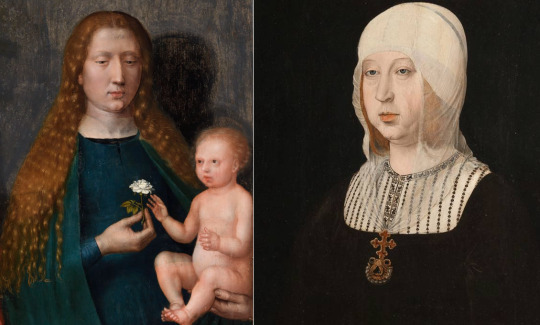
Several options to pick from: Pigments going wrong, Isabella's hair possibly turning to more reddish hues towards end of her life, or simply discoloured pinkish varnish which was very oddly applied...and on baby's skin you can see where somebody applied only one layer and where they went with brush for 2nd time.
If entire pannel has this varnish on, then it'd affect the hair, turning it more red. Why would such varnish not be removed? Sometimes money is tight and museums have multiple paintings to care for and those paintings in fairly good condition have to wait longer.
And sometimes it is not possible to remove discoloured varnish without harming the painting beneath.
Also worth of nothing is that Virgin Mary's dress is typically not teal, but vividly blue, the very best most expensive most vivid blue pigments were very often reserved for depicting the Virgin Mary:

Sometimes due to budget cost cheaper substitues were used, and those tend to fade.
Hence imo the colours originally might have been intended to be more like this(yes, I photoshopped it):

(I didn't change damn thing about male figure, just brightened it. But tbh I played with the woman's dress, skin and hair for while.)
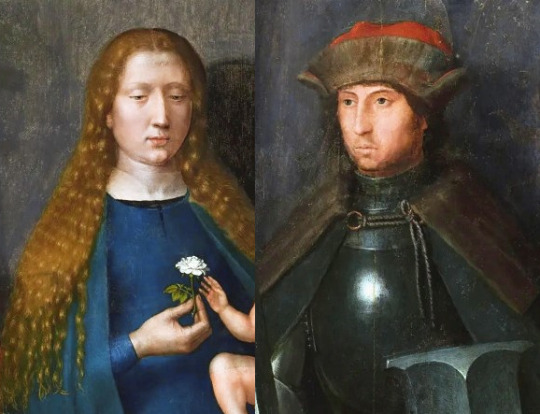
I mean if it looked like this now, fans of catholic monarchs would probably be all over it already.
But people overlook these dark slightly pinkish images located all the way in Estonia, even though it is atributed to Sittow himself!
(I don't mean people in Estonia, I mean people who search for Isabella's lost portrait by Sittow and stubbornly stuck to their favourite which is not even by Sittow!)

I honestly thought that people searching for lost portrait of Isabella by Sittow would have by now checked all his work, to see if perhaps she is there somewhere! Just doesn't look teen or young adult.
So I want you to be aware, if you're on quest of finding Isabella by Sittow's in that portrait with emerald necklace that this is imo the face you're looking for :

Possibly with hair bit more golden and skin more fair:
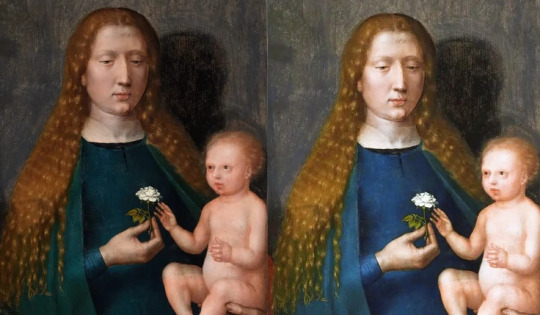
And it doesn't matter she doesn't look 20! She is still very beautiful.
Hence imo, these are Catherine of Aragon's parents, depicted in disguise of saints:

But I think they were likely painted years after Sittow left Spain, and his old sketches of them have been reused to create these pannels. I hope the experts will one day look more into this possibility.
I hope you've enjoyed this, and tell me what you think. Am I onto something or am I chasing shadows?


#historical portraits#isabella of castile#ferdinand of aragon#Isabella I of Castile#Ferdinand II of Aragon#sittow
69 notes
·
View notes
Text
Non Comprehensive List of the Nice Spanish Paintings That Mysteriously Ended Up in Marshal Soult's Collection
Sourced from the essay Seville's Artistic Heritage during the French Occupation in the book Manet/Velázquez: The French Taste for Spanish Painting, which can be downloaded for free on the Met's website which is frankly awesome but i wish someone OCRed their book
In 1852 at the sale of his collection, there were 109 paintings up for sale - 78 from the Seville School, including 15 Murillos and 15 Zurbaráns.
It's interesting that Soult wanted to legitimize his ownership of these paintings via receipts and official documentation - the biography of him I was machine translating talks about the king questioning his collection and him pulling out receipts for each painting. But, well, the essay puts it like this: "The existence of an official letter can be explained by Soult's desire to dress up in legal or formal terms what was in reality theft or extortion."
I might put excerpts from the essay in a different post, but for now, let's look at the list! Modern locations of the paintings are in parentheses, and I must say, for an essay critical of historical reappropriation of artwork, a lot of these artworks are still extant. Not a dig or anything, just an observation.
I do not condone extorting or stealing priceless Spanish artworks anyway
On with the show!
Murillo
The Immaculate Conception (Museo Nacional del Prado, Madrid)
Virgin and Child (Walker Art Gallery, Liverpool)
Saint Elizabeth of Hungary Nursing the Sick (Church of the Hospital de la Caridad, Seville)
Christ Healing the Paralytic at the Pool of Bethesda (National Gallery, London)
The Return of the Prodigal Son (National Gallery of Art, Washington, D.C.)
Abraham and the Three Angels (National Gallery Of Canada, Ottawa)
The Liberation of Saint Peter (State Hermitage Museum, St. Petersburg)
Saint Junipero and the Pauper (Musée du Louvre, Paris)
Saint Salvador de Horta and the Inquisitor Of Aragon (Musée Bonnat,
Bayonne)
Brother Julián de Alcalá and the Soul of Philip II (Sterling and Francine Clark Art Institute, Williamstown, Mass.)
The Angels' Kitchen (Musée du Louvre, Paris)
The Dream Of the Patrician (Museo Nacional del Prado, Madrid)
The Patrician John and His Wife (Museo Nacional del Prado, Madrid)
The Triumph of the Eucharist (Lord Farringdon Collection, Buscot Park, Farringdon, England)
Saint Augustine in Ecstasy [Not sourced from the above book, from a Christies auction actually]
Herrera the Elder
The Israelites Receiving Manna (unknown/destroyed?)
Moses Striking the Rock (unknown/destroyed?)
The Marriage at Cana (unknown/destroyed?)
The Multiplication of the Loaves and Fishes (Musée d'Amiens, destroyed in 1918)
Last Communion of Saint Bonaventure (Musée du Louvre, Paris)
Saint Basil Dictating His Doctrine (Musée du Louvre, Paris)
Zurbarán
Saint Apollonia (Musée du Louvre, Paris)
Saint Lucy Musée des Beaux-Arts, Chartres
Saint Anthony Abbot (private collection, Madrid)
Saint Lawrence (State Hermitage, St. Petersburg)
Saint Bonaventure at the Council of Lyon (Musée du Louvre, Paris)
Saint Bonaventure on His Bier (Musée du Louvre, Paris)
The Apotheosis of Saint Thomas Aquinas (Museo de Bellas Artes, Seville)
Saints Romanus and Barulas (Art Institute of Chicago)
paintings of the archangel Gabriel and Saint Agatha (both Musée de Montpellier)
Cano
Saint John with the Poisoned Chalice and Saint James the Apostle (both Musée du Louvre, Paris)
Saint John Giving Communion to the Virgin (Palazzo Bianco,
Genoa)
Saint John's Vision Of God (John and Mable Ringling Museum Of Art, Sarasota)
Charity and Faith (present location unknown; 1852 Soult sale)
Saint Agnes (destroyed in fire in the Staatliche Museen, Berlin)
Uncertain source, thought to be Murillo at the time
A Resting Virgin (usually identified as The Holy Family with the Infant Saint John the Baptist, Wallace Collection London)
The Death Of Abel
Saint Peter
Saint Paul
Other artists in his collection whose specific works weren't named
Sebastiån de Llanos Valdés
Pedro de Camprobin
José Antolinez
Sebastiån Gomez
#jean-de-dieu soult#jean de dieu soult#napoleon's marshals#napoleonic wars#napoleonic era#cad rambles about dead frenchmen on main#cadmus rambles
19 notes
·
View notes
Text

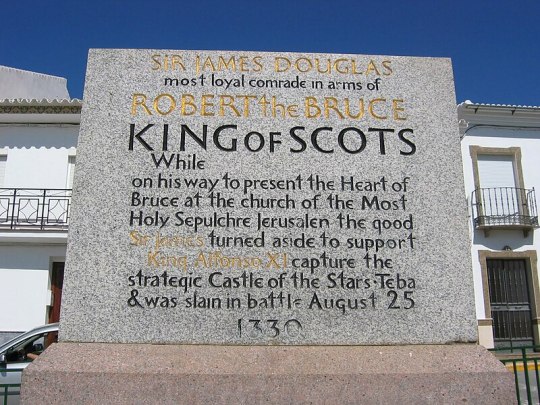
It was every medieval Knight's ambition to go on a Crusade, they saw it as a sense of duty. Robert the Bruce was no different, nor his faithful friend James Douglas, Lord of Douglas. The Bruce had been excommunicated barring him from taking the "pilgrimage" Sir James and he were rather busy as well, there was the matter of a war with England.
The English called Sir James "The Black Douglas" , the man was so frightening a wee verse has survived through the centuries that mothers used to whisper to their children when trying to get them to sleep.
Hush Ye, Hush Ye
Do not fret you,
The Black Douglas,
Will not get you.
The Douglas must have hated the English with a passion, his father Sir William Douglas, known as "le Hardi" or "the bold" had been one of the few nobles who openly supported Sir William Wallace, he died a prisoner of Longshanks in The Tower of London around 1298, the young James had been sent to France for safety during the early years of the Wars of Independence, and was educated in Paris, it was where he met William Lamberton, Bishop of St. Andrews, who took him as a squire. He returned to Scotland with Lamberton. His lands had been seized and awarded to Robert Clifford. Lamberton presented him at the occupying English court to petition for the return of his land shortly after the capture of Stirling Castle in 1304, but when Edward I of England heard whose son he was he grew angry and Douglas was forced to depart.
James seems to have went about his business after this not causing any problems of note until The Bruce took up arms against the English in 1306, it is clear that he had been starting to feel somewhat disgruntled about his lack of inheritance and, after Bruce’s return from exile a year later, the nineteen-year old joined the Scottish camp. Not long afterward, on Palm Sunday, he launched a swift and brutal attack on his castle of Douglas (held at this point by Lord Clifford) reportedly seizing the castle while the defenders were at church and shutting the garrison up in the cellar to burn to death. After Bruce’s victory at Loudon later that year, despite Douglas momentarily getting cold feet and attempting peace negotiations, he became active in the region that his descendants would draw their main strength from- the Borders.
And so it was that he fought with Bruce right through the campaign to free Scotland from Edwards tyranny.
Fast forward to 1330 and it is said Sir James was called to the bedside of King Robert as he lay dying he asked his loyal friend to remove his heart after death, place it in a casket, and take them on a pilgrimage to the Holy Land and bury his heart in the Holy Sepulchre at Jerusalem.
Sir James took Bruce’s heart, embalmed it then put it in a casket which he wore round his neck, and set off on the crusade to the Holy Land with a party of 25, made up of knights and noblemen, among them Sir William de Keith of Galston, Sir Robert Logan of Restalrig and his brother Sir John, Sir William de St Clair and his brother John de St Clair of Rosslyn ,Sir Alan Cathcart and Sir Symon Loccard of Lee.
Having been granted a promise of safe conduct from Edward III of England, the party sailed from North Berwick and made for Luys in Flanders in the spring of 1330 remaining there for 12 days and attracting more followers from all over Europe.
Their intention was to then sail to Cape Finnestere in the North West of Spain to visit Santiago de Campostella which had been ordained as a holy town by Pope Alexander lll following the discovery of the remains of the Apostle James.
A pilgrimage to Santiago captured the imagination of Christian Europe on an unprecedented scale as it was the 3rd holiest site in Christendom and at the height of its popularity in the 11th and 12th century attracted over half a million pilgrims each year.
However, before they could set off for Santiago word reached them that the King of Castile and Leon, Alphonso Xl , in his efforts to drive the Moors out of Granada had laid siege to the Castillo de las Estrellas(Castle of the Stars)at Teba which was occupied by the Saracen Army of Mohammed lV,Sultan of Granada.
Douglas sent word that they were prepared to join forces with Alphonso and sailed immediately to help, making landfall at Seville and marching the short distance to Teba.
Alphonso having heard tales of Douglas’s bravery and leadership skills gave him the right flank of the Castilian Army.
On the morning of the August 25th the Saracen army had assembled below the Castillo de las Estrellas under the command of Osmyn.
The Castilian trumpets sounded and Douglas, thinking it was a general advance, led his troops forward.
The Scottish contingent charged the Saracens and, although not fully supported by the rest of the army, managed to hold them, finally the Moors, unable to withstand the furious onslaught,fled.
Douglas, as was his custom, followed them until finding himself deserted, turned his horse with the intention of joining the main body.
Just then he observed Sir William St Clair surrounded by a body of Moors who had suddenly rallied. With the few knights who attended him Douglas turned hastily to attempt a rescue.
He soon found himself surrounded and, making one last charge shouting the words “A Bruce A Bruce”, took the casket containing the heart from around his neck and hurled into the enemies’ path shouting “Now go in front, as you desired and Ill follow you or die”.
Douglas and a party of his followers were all slain but they had diverted enough of the enemy forces away from the main thrust to enable the Castilian army to overrun the remainder and capture the Castle.
It has been speculated that the Moors lack of knowledge of European heraldry had a part to play in the death of Douglas.
Noblemen on both sides were valued as hostages, but because Douglas did not display the red cross on his tabard that distinguished English knights, but instead had the 3 stars of the Douglas family on his harness and shield, the Moors did not recognize his status or they would probably have spared his life.
Douglas’s body was recovered from the battlefield along with the casket, his bones, the flesh boiled off them, were taken back to Scotland by Sir William Keith of Galston in Ayrshire (who had missed the battle because of a broken arm), and deposited at St Bride's Church. The Heart of The Bruce was given to Regent Moray, who interred it under the high altar of Melrose Abbey.
The pics are one of Strathleven Artizans dressed as Sir James and the Memorial to Douglas at Teba.
40 notes
·
View notes
Text


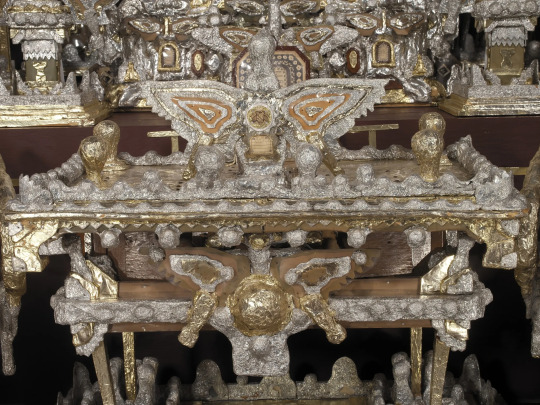
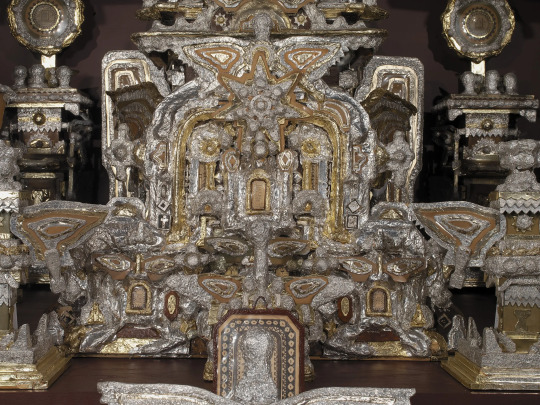
No, you know what? While I'm all fired up about modern art and outsider art, let me introduce you to the works of James Hampton.
Pictured above is his monumental Throne of the Third Heaven of the Nations' Millennium General Assembly.
With scant education and no formal art education, James Hampton made these pieces out of his intense religious fervor and his own desire to create:
In 1950, Hampton rented a garage on 7th street in northwest Washington [DC]. Over the next 14 years, Hampton built a complex work of religious art inside the garage with various scavenged materials such as aluminum and gold foil, old furniture, pieces of cardboard, light bulbs, jelly jars, shards of mirror and desk blotters held together with tacks, glue, pins and tape.
The complete work consists of 180 objects, many of them inscribed with quotes from the Book of Revelation. The centerpiece of the exhibit is a throne, seven feet tall, built on the foundation of an old maroon-cushioned armchair with the words "Fear Not" at its crest. The throne is flanked by dozens of altars, crowns, lecterns, tablets and winged pulpits. Wall plaques on the left bear the name of apostles and those on the right list various biblical patriarchs and prophets such as Abraham and Ezekiel.
The text The Throne of the Third Heaven of the Nations' Millennium General Assembly was written on the objects in Hampton's handwriting.
He constructed all his pieces from materials he found or scavenged himself, "such as aluminum and gold foil, old furniture, pieces of cardboard, light bulbs, jelly jars, shards of mirror and desk blotters held together with tacks, glue, pins and tape."
It's not clear if Hampton himself regarded himself as an artist, a visionary, a prophet, or none of the above. His work, however, is regarded as art in the same way that Michelangelo's Pieta is regarded as art: art of a religious subject or concept.
He also "kept a 108-page loose-leaf notebook titled St James: The Book of the 7 Dispensation. Most of the text was written in an unknown script that remains undeciphered. ... Some of the text was accompanied by notes in English in Hampton's handwriting. In the notebook, Hampton referred to himself as St. James with the title 'Director, Special Projects for the State of Eternity' and ended each page with the word 'Revelation'."
The art was not discovered until after Hampton's death in 1964, when the owner of the garage, Meyer Wertlieb, came to find out why the rent had not been paid. He knew that Hampton had been building something in the garage. When he opened the door, he found a room filled with the artwork.
Hampton had kept his project secret from most of his friends and family. His relatives first heard about it when his sister came to claim his body. When Hampton's sister refused to take the artwork, the landlord placed an advertisement in local newspapers. Ed Kelly, a sculptor, answered the advertisement and was so astounded by the exhibit, he contacted art collector Alice Denney. Denney brought art dealers Leo Castelli and Ivan Karp, and artist Robert Rauschenberg, to see the exhibit in the garage. Harry Lowe, the assistant director of the Smithsonian Art Museum, told the Washington Post that walking into the garage "was like opening Tut's tomb."
His work is now on display at the Smithsonian American Art Museum.
32 notes
·
View notes